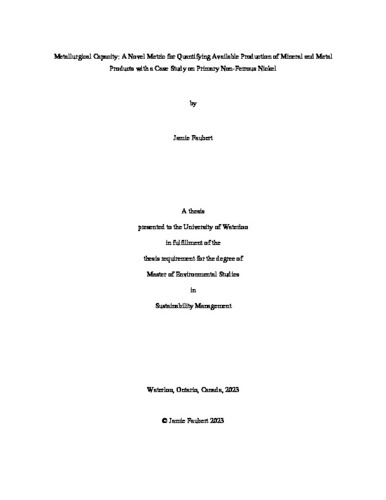| dc.description.abstract | Minerals and metals are indispensable to society. Beyond conventional uses in all goods and services, significant deployment of new minerals and metals in clean technologies will be necessary for decarbonization efforts. Modern mineral and metal supply chains are highly complex, with distributed production and disjointed ore bodies, processing routes, products, and operational characteristics. This research addresses the need for an assessment metric, “metallurgical capacity,” on the intricacies and nuances of mineral and metal supply that captures limitations and promises of midstream capacity. A bottom-up facility-by-facility approach is adopted for the metric. The underlying approach aims to provide accessible information for stakeholders to evaluate the ability of midstream operations to meet mineral and metal product requirements. To validate the utility of the metric and its approach, a case study of primary non-ferrous nickel supply was conducted for 2021. Nickel was selected due to its highly fragmented nature and utility in critical new technologies. Details and nuances of the metallurgical capacity metric were considered, and derivates of the metric related to attributes, such as operating status, excess capacity, ownership, feedstock, processing technologies, product class, product application, battery potential, and carbon neutrality commitments, were assessed. Data on operational, technical, product, and environmental attributes of applicable midstream operations were collected, primarily from published company annual reports. In total, 42 operations, producing 141 products, were assessed. Results show the metallurgical capacity of primary non-ferrous nickel products for 2021 was 1.6 million metric tonnes. Nickel products are primarily advertised towards metallurgical applications, and there remains a lack of products suitable to meet the projected demand from batteries, particularly high-quality nickel sulphate. The scope and granularity afforded by the approach allowed for an extensive discussion of potential supply chain bottleneck risk. Insufficient midstream non-ferrous nickel supply capacity expansion could result in considerable supply bottlenecks for nickel applications that could reverberate to alternative mineral and metal supply chains. In all, the metallurgical capacity demonstrates considerable promise in expanding knowledge of mineral and metal supply chains. Applying the metric to other mineral and metal supply chains would support efforts to improve decision-making among stakeholders. | en |

